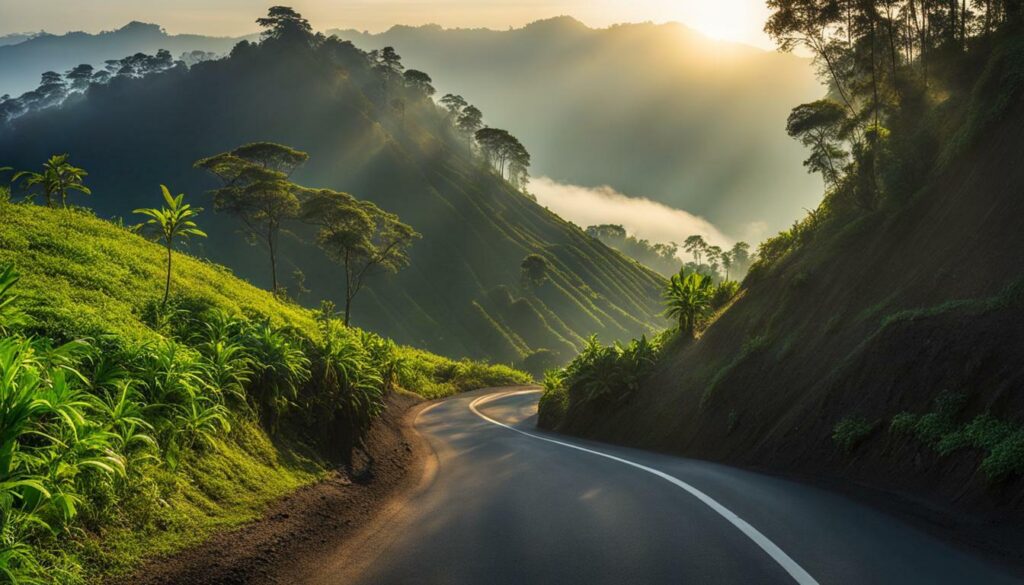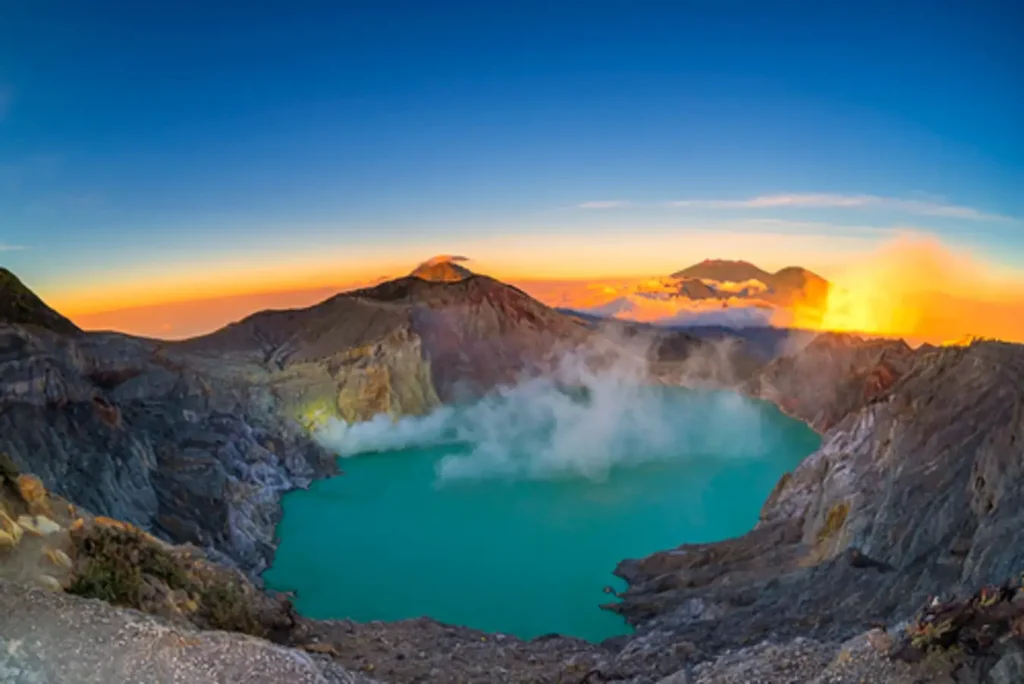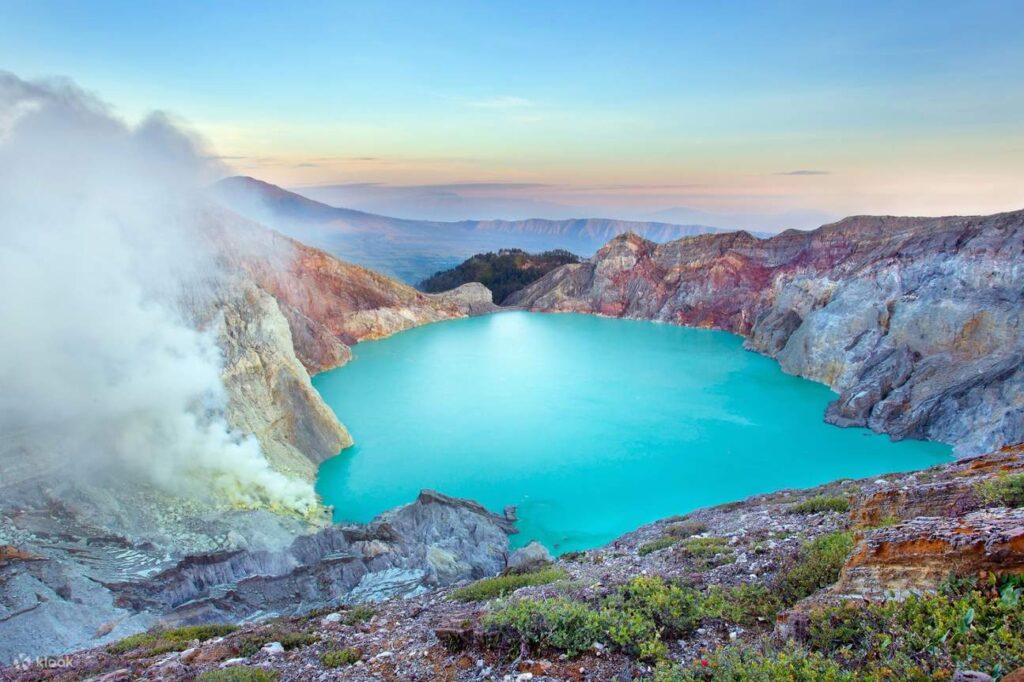Banyuwangi, located on the easternmost tip of Java in Indonesia, is a city known for its natural beauty and rich cultural heritage. It serves as the gateway for visitors looking to explore the captivating Ijen Crater, a stunning volcanic site that boasts a turquoise-colored lake and the famous blue fire phenomenon. In this guide, we will provide a comprehensive travel guide for those planning to visit Banyuwangi and the Ijen Crater.
Whether you’re an adventure seeker or a nature lover, Banyuwangi has something to offer for everyone. Aside from the mesmerizing Ijen Crater, the city is home to various stunning beaches, natural reserves, and historical sites. With this guide, you can explore all the wonders Banyuwangi has to offer, from transportation options to popular tourism activities.
Key Takeaways
- Banyuwangi is located on the easternmost tip of Java in Indonesia, and serves as a gateway to the Ijen Crater.
- Ijen Crater is a stunning volcanic site that attracts visitors with its turquoise lake and blue fire phenomenon.
- Banyuwangi is not only a city of natural beauty, but also rich in cultural heritage.
- This guide will provide a comprehensive travel guide for those planning to visit Banyuwangi and the Ijen Crater.
- Explore Banyuwangi’s stunning beaches, natural reserves, and historical sites, as well as transportation options and popular tourism activities.
Getting to Banyuwangi
Before embarking on your journey to Ijen Crater, you’ll need to first get to Banyuwangi, a vibrant city located on the easternmost tip of Java island.
The most convenient way to get to Banyuwangi is by plane, as the city is served by its own airport, Blimbingsari Airport. The airport is located about 30 minutes away from the city center and is well-connected to several Indonesian cities, such as Jakarta, Surabaya, and Bali.
Alternatively, you can also travel by train or bus. The nearest train station is Banyuwangi Baru, which has regular services from major cities in Java, such as Yogyakarta and Surabaya. Buses are also available from several neighboring cities, including Surabaya, Denpasar, and Probolinggo.
It’s important to note that visas may be required for some travelers visiting Indonesia. It’s recommended to research visa requirements and apply well in advance if necessary.
Once you arrive in Banyuwangi, there are several transportation options available to explore the city and reach Ijen Crater. Taxis, motorbikes, and rental cars are all available for hire. It’s also possible to join an organized tour, which can provide a convenient and hassle-free option for exploring the area.
Exploring Banyuwangi
Banyuwangi is a vibrant city located on the eastern coast of Java, Indonesia. Known as the gateway to Bali, this city has become increasingly popular among tourists for its stunning natural beauty and cultural landmarks.
One of the top attractions in Banyuwangi is the Alas Purwo National Park, a nature reserve that covers over 43,000 hectares of land. The park is renowned for its beautiful beaches, such as Trianggulasi Beach and Plengkung Beach, which are popular among surfers around the world. Visitors can also explore the traditional villages and historical sites located within the park, such as the ancient Hindu temple of Giri Salaka.
Another must-visit attraction in Banyuwangi is the Baluran National Park, which is often referred to as the “little Africa” of Java due to its resemblance to the African savannah. The park boasts a diverse range of flora and fauna, including endangered species such as the Javanese bull, as well as breathtaking landscapes that will leave you in awe.
If you’re interested in the local culture, there are also plenty of cultural landmarks worth visiting in Banyuwangi. The Banyuwangi Museum, for instance, is a great place to learn about the history and traditions of the local people, while the Blambangan Museum showcases the ancient culture of the Blambangan Kingdom that once ruled the city.
For those who love outdoor activities, Banyuwangi has plenty to offer. The city is home to the Ijen volcano, which is famous for its blue fire phenomenon and stunning views of the crater lake. Visitors can take a guided tour or hike to the summit of the volcano to witness this natural wonder up close. Additionally, there are many beaches and waterfalls in Banyuwangi that are perfect for swimming, snorkeling, and other fun water activities.
Finally, no trip to Banyuwangi is complete without trying the local cuisine. Some of the must-try dishes include nasi tempong (rice with various side dishes), sate (grilled skewered meat), and pecel (vegetables with peanut sauce). You can find these dishes at local street stalls or restaurants throughout the city.
Journey to Ijen Crater
After exploring the sights and sounds of Banyuwangi, it’s time to journey to Ijen Crater. There are several options available for reaching the crater, including guided tours and independent treks.
If you’re up for an adventure, the Ijen volcano trek is an amazing experience. This challenging trek takes you through the lush forests surrounding the volcano and up to the rim of the crater.
For those who prefer a more relaxed journey, guided tours are available from Banyuwangi. These tours typically include transportation to the crater, a local guide, and necessary safety equipment. One popular option is the Banyuwangi to Ijen blue fire tour, which allows you to witness the mesmerizing blue flames that emanate from the crater at night.
If you’re staying in Banyuwangi, it’s easy to arrange a visit to Ijen Crater. It’s approximately a two-hour drive from the city, and there are plenty of local tour operators and transportation options available. Visiting Ijen Crater from Banyuwangi is a must-do activity for any traveler to the area.
Ijen Crater Experience
Visiting Ijen Crater is an unforgettable experience, offering breathtaking views and unique opportunities to witness the power of nature at work.
If you opt for a guided tour, you’ll be led by an experienced local guide who can share their knowledge of the crater’s history and geology. They will also provide safety gear, including masks to protect against the sulfur fumes.
The hike to the crater can be strenuous, so it’s important to wear comfortable, sturdy shoes and bring plenty of water. The trek typically takes around 1-2 hours depending on your fitness levels.
Ijen Crater Sunrise Tour
For those who want to witness the crater at its most stunning, a sunrise tour is a must. The early morning hike can be challenging, but the reward is well worth it as you watch the sun rise over the ethereal blue lake and the steam rising from the sulfur vents.
Pro tip: Be sure to bring warm clothing as temperatures at the top can drop to around 10 degrees Celsius.
Ijen Crater Hiking
The hike down to the crater is not for the faint of heart, with steep, rocky terrain and sulfur fumes to contend with. However, the reward at the bottom is incredible, with the chance to see the miners at work and witness the vibrant colors of the sulfur crystals up close.
For those who want to get even closer to the action, it’s possible to hike up to the rim of the crater. This is a challenging trek and should only be attempted by experienced hikers with appropriate safety gear.
Ijen Crater Tour
The tour of Ijen Crater is an immersive experience that will leave you with a newfound appreciation for the power of nature. The trek to the crater and back can take anywhere from 4-6 hours, depending on your pace and chosen route.
Don’t forget to bring your camera to capture the stunning landscape and unique experiences along the way.
Additional Tips and Recommendations
As you plan your trip from Banyuwangi to Ijen Crater, keep these tips and recommendations in mind to enhance your experience:
Accommodation
There are a variety of accommodations available in Banyuwangi to suit different budgets and preferences. If you’re looking for a luxurious stay, consider the plush resorts and hotels in the city. For a more affordable option, guesthouses and homestays are available, offering a cozy and authentic experience. It’s recommended to book your accommodation in advance, especially during peak season.
Local Cuisine
Banyuwangi is famous for its unique and flavorful cuisine, blending Javanese and Balinese influences. Be sure to try the local specialty dishes such as nasi jagung (corn rice), sate buntel (wrapped satay), and pecel (vegetable salad with peanut sauce). For a sweet treat, try the traditional dessert of wedang ronde (glutinous rice balls in ginger syrup).
Nearby Attractions
While in Banyuwangi, don’t miss out on visiting its other attractions such as the Baluran National Park, Alas Purwo National Park, and the Red Island Beach. These picturesque locations offer a glimpse into the natural beauty of East Java.
Safety Measures
When embarking on the Ijen volcano trek, it’s important to take necessary safety measures. This includes wearing appropriate footwear, bringing warm clothing, and protecting yourself from sulfur fumes. It’s recommended to hire a professional guide to ensure safe trekking and to follow their instructions carefully.
Packing Essentials
When packing for your trip from Banyuwangi to Ijen Crater, don’t forget to bring essentials such as sunscreen, insect repellent, a first aid kit, and a refillable water bottle. It’s also recommended to bring a flashlight or headlamp for the early morning hike to the crater.
Conclusion
With these additional tips and recommendations, you’re all set to embark on an unforgettable journey from Banyuwangi to Ijen Crater. Enjoy exploring the vibrant city and its numerous attractions before embarking on the breathtaking trek to the crater. Safe travels!
Conclusion
Traveling from Banyuwangi to Ijen Crater is an unforgettable adventure that offers breathtaking views and cultural experiences. By following this complete travel guide, you can plan your trip with ease and enjoy all that this beautiful destination has to offer.
From exploring the top tourist attractions of Banyuwangi to witnessing the ethereal beauty of Ijen Crater, this journey is one that you’ll cherish for a lifetime. Whether you’re an adventure seeker or a nature lover, this destination has something for everyone.
Make sure to take advantage of the various transportation options available to get to Banyuwangi, and plan your trip carefully to ensure you have enough time to explore this vibrant city and its surrounding areas. Don’t forget to pack any necessary travel documents and equipment for your trip.
Takeaway Tips
- Book your transportation in advance to save time and avoid any inconvenience.
- Explore the top tourist attractions of Banyuwangi, including its beautiful beaches and cultural landmarks.
- Witness the famous blue fire phenomenon at Ijen Crater and take safety precautions during the trek.
- Plan your trip carefully to ensure you have enough time to enjoy all that this destination has to offer.
- Try the local cuisine and immerse yourself in the local culture to enhance your experience.
With these tips and the information provided in this guide, you’re ready to embark on an unforgettable journey to Banyuwangi and Ijen Crater. Enjoy the beautiful scenery, cultural experiences, and adventure that await you!
FAQ
Can I visit Ijen Crater without going through Banyuwangi?
Banyuwangi is the closest city to Ijen Crater and serves as the main gateway for visitors. While it is possible to reach the crater from other cities, such as Surabaya or Bali, the journey will be longer and more challenging.
What is the best time to visit Banyuwangi and Ijen Crater?
The best time to visit Banyuwangi and Ijen Crater is during the dry season, which typically runs from April to October. During this time, weather conditions are more favorable for trekking and exploring the crater without heavy rainfall.
How long does it take to hike to Ijen Crater?
The hike to Ijen Crater usually takes around 1.5 to 2 hours, depending on your fitness level and pace. The trail is steep and can be challenging, so it’s important to wear proper hiking shoes and take breaks as needed.
Is it safe to visit Ijen Crater?
While visiting Ijen Crater is generally safe, it’s important to take necessary precautions. The sulfur gases emitted by the crater can be harmful if inhaled directly, so it’s recommended to bring a gas mask or a cloth to cover your nose and mouth. Additionally, it’s important to stay on designated paths and follow the instructions of your guide to ensure a safe experience.
Can I see the blue fire phenomenon at Ijen Crater?
Yes, the blue fire phenomenon can be witnessed at Ijen Crater, but it’s only visible during the dark hours of the night. It is a rare natural phenomenon caused by the combustion of sulfuric gases. To witness this spectacle, it’s recommended to take a guided tour that includes a night hike to the crater.
What is the recommended attire for visiting Ijen Crater?
It is advisable to wear comfortable and breathable clothing, appropriate for hiking. Long pants and long-sleeved shirts are recommended to protect against insect bites and contact with sulfur. Don’t forget to wear sturdy hiking shoes and bring a hat, sunglasses, and sunscreen to protect against the sun.





